Lens Power for the Flower
The Nikon AF-S VR Micro Nikkor 105 mm f2.8G ED
Since a while I was monitoring the macro lens market for a good new lens for macro flower work . So far the Micro Nikkor 60 mm AF-D f2.8 wasnt that bad at all for most of what I did. It was a compact sharp lens in the mm-range of the old famous Nikon 55 mm f.2.8 AIS Macro. There was however one area where the 60 mm was definitly not getting it right: bokeh (or I should say out of focus area rendering). The 60 mm was also a bit on the short side mm-wise. You tend to get too close to objects/subjects with this lens. The new Micro Nikkor beasts are much much better in that Bokeh-domain and the AF-S Micro Nikkor 105 mm f2.8G ED VR is the more useful of the two “N” Micro Nikkors (the other is the 60 mm AFS f2.8G). “More useful” because for most of the things you will likely need more shooting distance. I am also waiting for the update of the 200 mm Version. This one would be the one to go for if you are very much into insects and other shy subjects.
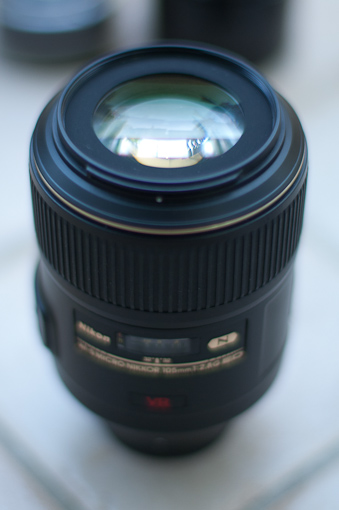
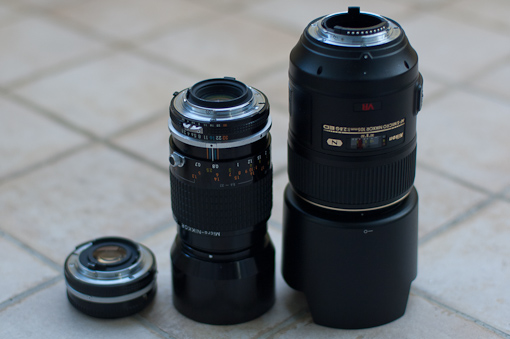
The 105VR is a big lens – compared to the old AIS 105mm f2.8 design (in the middle). This lens is huge but imo it sits nicely in your hand and focusing the large rubber ring with this diameter is very smooth and gives lots of control for drawing the out of focus areas.
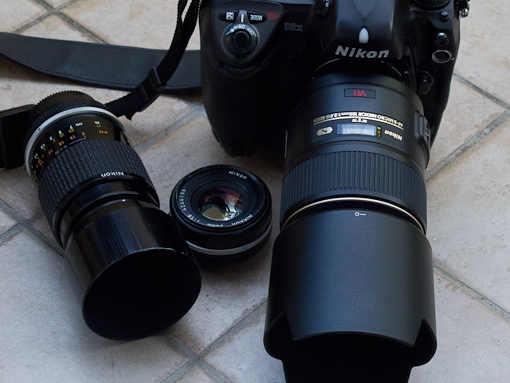
The 105VR compared to the old AIS 105mm f2.8 design mounted on a D2x.
The 105VR (lets keep it short) uses every technique abbreviation available to Nikon: VR (Vibration Reduction), N (Nano Coating), AFS (Ring type ultra sonic focusing with manual override – and this lens is a real “Lord of the Rings” and doesnt use a micro motor), it comes with rubber sealings, metal body construction and nine rounded blades that form a perfect circle when the aperture is closed. AFS isnt very useful in the near range and usually I leave it off but mine has a constant back focusing. The build quality is excellent with a robust metal body and the pro heavy duty build approach of other lenses in this range. The lens hood is made of plastic but also seems to be very robust and durable. The lens was originally made in Japan (Toshagi lens plant) but is now manufactured in China. I had both versions in my hands and I couldn find a significant difference – although I have to say that I kept the “made in Japan” version (stupid habit but I prefer Nikon stuff “Made in Japan”).
So whats so special with this lens? – its how the background is blurred! Its all about the out of focus highlights and thats where the lens shines. It gives butter-smooth out of focus color transitions with remarkably soft character. The only other macro competition imo is the Zeiss 100 mm f2 ZF2-mount version and the Voigtländer APO Lanthar 125 mm f2.5 . The Voigtländer is not available anymore and used market prices are at about 250-350% of the original price of the lens. The reason for this hefty price tag is that the Voigtländer 125 is the only macro lens in that range that is nearly lens aberration free. Its THE perfect corrected lens and for those into shooting jewelry and related objects this can be a very important aspect. The Zeiss is probably a bit sharper compared with the Nikkor but the Zeiss comes without AF-S and this can be important for other (non-macro) applications of the lens (its irrelevant for macro work though). The Zeiss also shows some CA and for the price imo you do not get what you pay for. Others might think different here. If you like the Zeiss rendering the website of Digilloyd http://zeissguide.com/ is a good read for you.
Its a bit different with the Voigtländer but this lens is just not available on the market anymore. Most of the happy owners do not sell their 125. Of the other third party lenses the Tamron 180 mm should be mentioned but its not exactly in the mm-range of the 105. Also Sigma does some nice lenses for macro work but with the Sigmas sample variation you should always order 5 lenses and keep the best one :). So I usually stay away from Sigma.
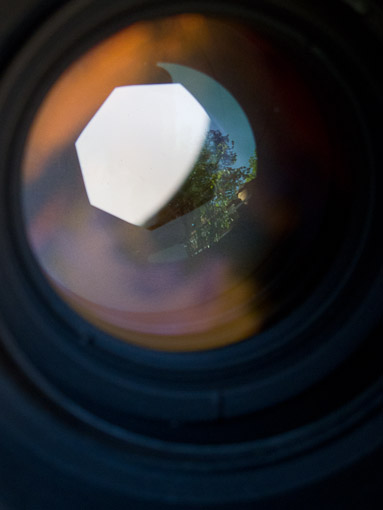
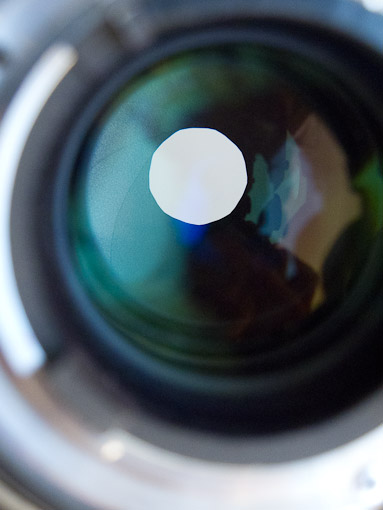
Figure: The 105VR creates nearly perfectly rounded OOF highlights due to its rounded aperture blades (see figure below), whereas the old AIS 105mm f2.8 design (above) gives the usual shapes here.
Drawbacks of the Nikkor 105VR:
1. it doesnt work with your ancient bellows (namely PB-4 – PB-6) as its a G-Type of lens! If you want to go beyond 1:1 sizes this lens could be combined with a TC (tele converter) – not too much of a good idea.
2. it changes the focal length with focusing – this can be a problem if you are framing very tight – the framing changes if your focus point shifts. Its kind of annoying. AND this is a NoGo if you do focus stacking with lots of frames!
There is a lot of information online about the Nikkor. To list a few of the important reviews: here is what should be on your list if you want more information about the lens:
– Thom Hogans Review of the 105VR
– Nikon Glass Review of the 105VR
– Simpho Review of the 105VR
– Björn Roersletts mini_review of the 105VR
– the Photozone APS-C test report of the 105VR
and if you ever wondered how this lens is build you might want to check this site:
A large gallery of flower shots with the 105VR is avail. here:
http://soeren.zenfolio.com/105vr